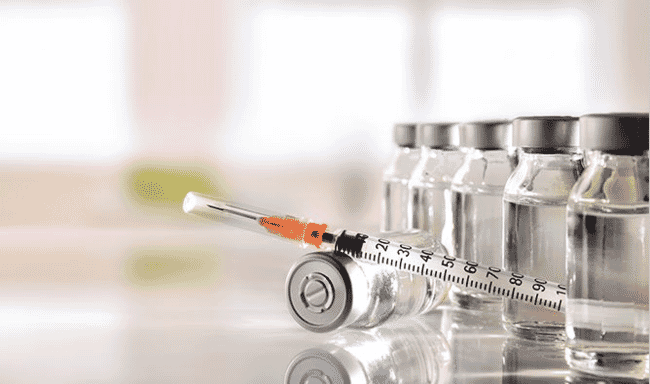
© Pharmaq
How did the idea of micro-dose vaccines come about, and why have they risen to prominence?
In the 1990s, we were vaccinating fish with a relatively high vaccine dose of 0.2 millilitres, which in some cases resulted in severe adverse reactions in the abdominal cavity. A vaccine with half that volume entered the Norwegian market in the mid-‘90s and was well accepted, as it reduced adverse reactions without reducing efficacy and smaller fish could be vaccinated. In 2003, Pharmaq launched its own, 0.1 millilitre-dose, multivalent vaccine for Atlantic salmon, which protected fish against infections with various Vibrio pathogens, Aeromonas salmonicida, Moritella viscosa and infectious pancreatic necrosis virus. Then, in 2008, Pharmaq launched the micro concept: the same antigens, injected in a 0.05 millilitre dose. This was the first product of its kind.
The idea with the micro-dose concept was to minimise the level of side-effects, without compromising vaccine efficiency. Because producers weren’t used to the micro vaccine, there was some doubt in the market over whether it offered sufficient long-term protection against the different antigens in the vaccine, so the adoption of the new product was slow in the beginning. Things have changed since, and we now have nine micro-dose vaccine products against economically important pathogens available around the world. Despite the early scepticism in the salmon market, they ultimately acknowledged that the performance of the fish vaccinated with the micro-dose products was better than with the previous vaccines.
What are the advantages for the industry of using a micro-dose product over a higher-dose vaccine?
By using a micro-dose (dose volume of 0.05 millilitres), you are able to vaccinate smaller fish, which provides not only greater flexibility for the fish farmer but also more time to build up an immune response before transfer to sea. There are reduced adverse reactions, but the efficacy is as good as the higher dose-volume products from the old days. Furthermore, with a base vaccine of small-dose volume, more vaccines can be applied together in the same operation.

What type of adverse reactions do micro-dose vaccines help to reduce?
Micro-dose vaccines have played an important role in minimising side effects from fish vaccination, including local inflammation and pigmentation in the abdominal cavity, a prolonged period before fish return to normal feeding and, potentially, downgrading of the fish fillets. Any adverse reactions are typically in a more confined region for fish vaccinated with the micro-dose compared to a normal 0.1 millilitre injection dose.
Reduced adverse reactions lead to better fish growth and improved fish welfare, which I think is the main reason for the success of micro-dose vaccines. Fish farmers’ main task is to grow fish biomass as efficiently as possible, and the micro dose contributes to that.
Can you give specific examples from the field?
Together with the Norwegian ova producer SalmoBreed (now part of Benchmark), Pharmaq has shown that fish given the micro dose have a better growth rate, especially during the first months after vaccination, when compared to the full dose. Their experience shows that fish vaccinated with a micro-dose also tend to get back to full-scale daily feeding much faster than fish injected with a 0.1 millilitre dose.
Applying the micro-dose also seems to reduce stress and make fish less susceptible to other pathogens following vaccination. In the Canadian, Chilean and UK salmon markets, for example, they have some fungal challenges with Saprolegnia. Some farmers have found that with micro-dose vaccines, they have fewer fungus issues.
You mentioned that micro-dose vaccines enable the administration of multiple injectable vaccines at the same time. Why is this important? Doesn’t it defeat the purpose of having smaller amounts of vaccine to start with?
Administering a number of vaccines in one injection is useful to farmers as it reduces the level of stress to the fish, as well as the labour intensity required on site.
Pharmaq also believes that instead of making new seven- or eight-component vaccines, future products will be a combination of base micro-dose, multivalent vaccines injected with a monovalent or bivalent vaccine, while still not exceeding a 0.1 millilitre total dose. This will continue to secure fish welfare and induce a faster supply of vaccines containing new antigens.
How does product development differ between a traditional, multivalent vaccine product and a micro-dose?
Development is more demanding for micro-dose products, as you have to combine several antigens into much smaller volume. You need to get a higher output on production and balance the antigen levels for the different pathogens in the vaccine. The downstream processing for the components is also more challenging. Pharmaq’s years of experience in developing micro-dose vaccines have proved valuable in this respect, and the result has been refined vaccines that continue to meet fish farmers’ expectations.
Are there any challenges that can arise when delivering micro-doses? If so, how are these addressed in the field?
Farmers generally like to administer all vaccines at the same time, which after some training is done without any problem. Pharmaq has tested all vaccination equipment for applying one, two or three vaccines in one shot. Vaccines with similar physicochemical properties (density and viscosity) are usually mixed before the injection. When combining non-mixable vaccines — for example, a micro-dose emulsion with a water-based vaccine — it’s even more important to ensure even dosing, by carefully designing the injector and testing its dosing performance.
Another concern that farmers sometimes have with micro-dose vaccines is whether they will offer the same long-term protection as 0.1 millilitre vaccines. It is logical to think that you will find vaccine residues over a longer period in fish injected with a larger dose compared to a micro-dose volume, but fieldwork and controlled studies actually show the opposite is true.
When doing vaccination follow-ups with our customers, we therefore focus on the quality of vaccination, including whether fish are evenly vaccinated and whether the vaccine has been injected in the correct area. Ultimately, close cooperation with fish farmers and letting them get experience with the products is a very important way to introduce them to new technology.
We’ve heard about the direct benefits in terms of fish health. Are there any broader, more strategic benefits to the use of micro-dose products?
Multivalent, micro-dose vaccines bring flexibility and speed to new developments in the aquaculture industry, because they can be used alongside new monovalent and divalent vaccines. From a market perspective, this is important because it usually takes several years to develop and approve a new multivalent product. By contrast, monovalent vaccines generally take less time to develop and can be applied alongside the base, multivalent micro-product. So, it’s a faster way to tackle new challenges in the industry. Once you’ve done the hard work of designing a successful micro-dose product, you can also produce more doses faster, making it easier to meet increasing demand for the vaccines.
What’s next? Are there any new markets opening up for micro-dose products, and could doses go even lower than they have so far?
Micro-dose vaccines are increasingly being used throughout the aquaculture industry. Currently there are ongoing trials of new vaccines for several new species in various parts of the world: sea bass in the Mediterranean, tilapia in Central and South America and pangasius in Vietnam. From a manufacturing perspective, lower injection volumes also mean more doses can be produced, which will ultimately enable us to better serve both established and emerging markets around the world.
This article was originally published on Pharmaq’s Fish Health Forum.




